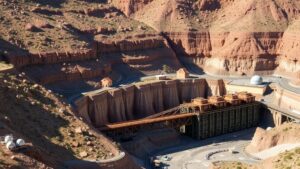The Legalities of Operating Heavy Equipment on Your Mining Claim
The Legalities of Operating Heavy Equipment on Your Mining Claim
Operating heavy equipment on your mining claim involves navigating a complex web of legal regulations and requirements. Understanding these legalities is crucial for maximizing operational efficiency while avoiding costly penalties or legal disputes. This article aims to clarify the fundamental legal frameworks affecting mining operations and provide actionable insights for claim holders.
Understanding Mining Claims
A mining claim grants the holder certain rights to extract minerals from a specific area of public land. e claims are primarily governed by federal and state laws. In the United States, the General Mining Act of 1872 primarily regulates mining on federal lands, while individual states have their own regulations. It is important to note that just because you hold a claim does not mean you are free to operate heavy machinery without adhering to legal standards.
Permits and Licenses
One of the most critical legal aspects of operating heavy equipment on a mining claim is obtaining the necessary permits. Different types of equipment may require different permits depending on the scope of work being done. Key permits may include:
- Environmental Permits: These permits ensure that mining activities comply with regulations such as the Clean Water Act and the National Environmental Policy Act (NEPA). Failing to obtain these can result in substantial fines.
- Operational Permits: Depending on the state, operational permits specific to heavy equipment may be required. For example, in California, a Permit to Mine is mandatory before any mining activities can commence.
- Land Use Permits: Mining operations may also require land use permits, particularly when operating near protected areas or residential zones.
Compliance and Best Practices
Compliance with local, state, and federal regulations is not optional; it is essential for sustaining your mining operations. Conducting a thorough compliance audit can help identify areas that may need attention. Also, employing best practices in machine operation can help mitigate legal risks.
- Regular Maintenance: Keeping heavy machinery in good condition can prevent accidents and reduce environmental impact, thereby adhering to legal standards.
- Employee Training: Providing comprehensive training for all operators can minimize the chance of accidents, which can lead to legal liabilities and insurance claims.
- Environmental Impact Assessments: Before initiating operations, conduct assessments to identify and mitigate environmental damages. This proactive approach may be viewed favorably by regulatory bodies.
Case Study: Environmental Compliance
A notable case that highlights the importance of compliance is the 2016 incident involving a gold mining operation in Alaska. The company failed to secure adequate environmental permits for using heavy equipment in a sensitive watershed, resulting in significant legal penalties that exceeded several million dollars. This case reinforces how critical legal adherence is, especially when dealing with environmental implications.
Common Questions and Concerns
While navigating the legalities of operating heavy equipment on mining claims, prospective claim holders often have similar concerns. Common questions include:
- Can I operate heavy machinery without a permit? Typically, no, as operating without the necessary permissions can lead to legal repercussions.
- What happens if I violate a mining regulation? Violating regulations can lead to fines, penalties, or even the revocation of your claim.
- Are there legal protections for miners? Yes, miners have certain rights under the Mining Law; however, these do not exempt them from adhering to local and federal regulations.
Conclusion: Take Action
Operating heavy equipment on your mining claim requires careful consideration of the legal environment. To operate lawfully and effectively:
- Conduct thorough research on legal requirements specific to your territory.
- Obtain all necessary permits before commencing any operations.
- Use best practices and regular audits for compliance.
Ultimately, understanding the legalities surrounding your mining claim will not only protect you from potential legal issues but will also contribute to more sustainable and responsible mining practices.



